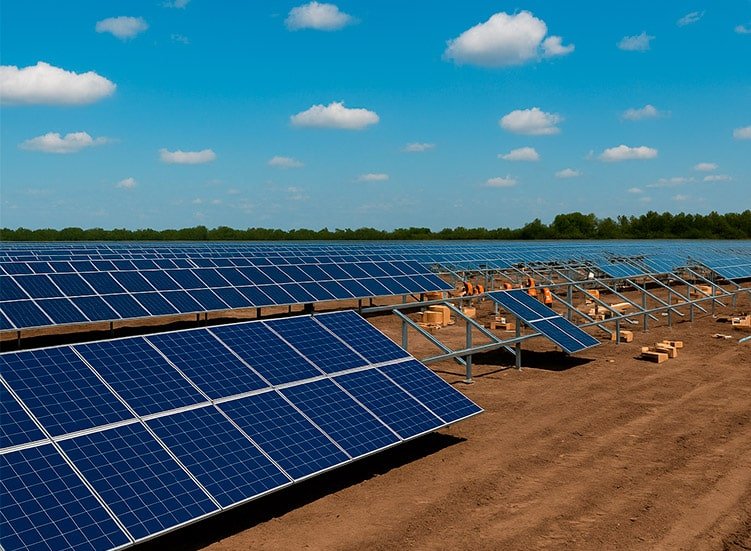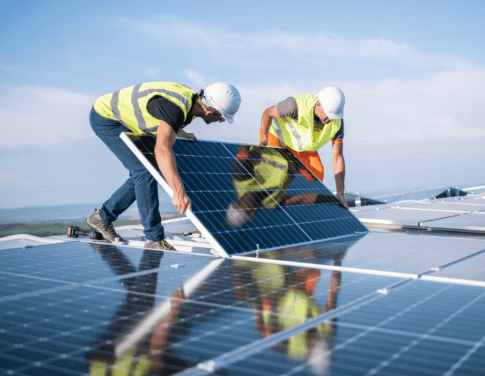With the growing demand for clean energy sources and technological advances in the photovoltaic sector, real opportunities are emerging for anyone—even without experience—to learn how to build a solar power plant and turn it into a source of guaranteed monthly income. Investing in solar energy has become one of the smartest ways to generate passive income with safety and a positive impact on the environment.
While solar energy has become one of the smartest ways to generate passive income with safety and sustainability, understanding how to build your own solar power plant can open the door to real financial opportunities. To explore this topic in depth, click here and check out the full article on Agribusinessplay.
⚙️ Before learning how to build a solar power plant, understand what it is and how it works
A private solar power plant uses photovoltaic panels to convert sunlight into electricity. These panels are made up of photovoltaic cells that, when exposed to sunlight, generate direct current (DC). This current is then converted into alternating current (AC) through inverters, making it compatible with the power grid or the devices that will use the energy.
The generated energy can be used for personal consumption—reducing dependence on the power grid—or injected into the grid, generating credits or revenue, depending on local regulations.
🔋 Energy storage: how does it work?
Energy storage in solar power plants is done through batteries, which store surplus energy generated during the day to be used at night or during low-sunlight periods. The most common types of batteries are:
- Lead-acid batteries: more affordable, but with shorter lifespan and lower efficiency.
- Lithium-ion batteries: longer-lasting and more efficient, although with a higher upfront cost.
Using batteries provides greater energy independence and may be essential in areas with unreliable power supply or in off-grid systems (not connected to the grid).
⚡ Types of solar power plants
Before building your own solar power plant, it’s essential to understand the three main models. Each one fits different consumption profiles, investment levels, and returns. See below:
🔌 1. Grid-connected solar power plant (On-Grid System)
This is the most common model worldwide. In this system, the solar power plant is connected to the public power grid, which means the energy generated by the solar panels can be used directly, and any surplus can be sent to the grid.
According to U.S. regulations (including policies governed by the Federal Energy Regulatory Commission – FERC and state-level agencies), consumers can generate their own energy and send the surplus into the power grid, receiving credits or compensation.
👉 Click here to visit the official page of the Federal Energy Regulatory Commission (FERC).
- Is used to power your home, business, or property;
- The surplus is injected into the grid and converted into energy credits;
- These credits are deducted from your electricity bill during periods of low generation (such as cloudy days or nighttime).
✅ Advantages:
- More affordable cost (does not require batteries);
- Faster financial return;
- Ideal for generating savings or monthly income through energy compensation.
🔋 2. Off-Grid solar power plant (Isolated System)
In this model, the plant is not connected to the public grid. All the energy generated is stored in batteries and used locally.
It is a very common option in rural or remote areas, where there is no reliable access to the power grid.
✅ Advantages:
- Complete energy independence;
- Works even in places without access to the public grid.
⚠️ Disadvantages:
- Higher cost (requires batteries);
- Requires technical planning to avoid interruptions.
⚡🔋 3. Hybrid solar power plant (On-Grid + Off-Grid)
The hybrid plant combines the best of both worlds: it is connected to the power grid but also has batteries for energy storage.
This system offers greater energy security because:
- It uses solar energy during the day;
- Stores part of it in batteries for later use;
- And still injects the surplus into the grid, generating credits or income.
✅ Advantages:
- Ensures power even during blackouts;
- Allows financial return with credits and/or sale of surplus;
- Ideal for those seeking stability and energy security.
🧭 Which type of solar power plant is best for you to invest in?
The best choice depends on your goal:
| Profile | Type of Plant | Reason |
|---|---|---|
| Looking for savings and quick return | On-grid | Lower cost and more direct return |
| Lives in an area without power grid | Off-grid | Total grid independence |
| Wants energy security and autonomy | Hybrid | Combines stability with performance |
If your goal is to profit from solar energy, the on-grid or hybrid plant is usually the best choice, especially in urban or semi-urban areas.
💡 Ways to Invest in Solar Energy.
1. Residential Installation for Self-Consumption
By installing solar panels at your home, you significantly reduce your electricity bill and can sell surplus energy back to the grid, depending on local regulations.
Advantages:
- Reduction of up to 95% on the electricity bill.
- Return on investment (ROI) typically in 3 to 5 years.
- Increased property value.
Considerations:
- Need for initial investment or financing.
- Available space for panel installation.
2. Investment in Shared Solar Plants
Participating in solar energy consortia or cooperatives allows you to invest in a portion of a solar plant and receive a share of the revenue generated.
Advantages:
- Access to solar energy investments without needing physical space.
- Passive income proportional to the investment.
- Diversification of investments.
Considerations:
- Importance of verifying the reputation and regulation of the cooperative.
- Possible variations in energy generation due to weather conditions.
3. Land Leasing for Solar Plants
If you own land in an area with good solar incidence, you can lease it to companies that want to install solar plants, receiving monthly income for the use of the space.
Advantages:
- Generation of passive income without investment in infrastructure.
- Utilization of idle land.
Considerations:
- Need for well-drafted contracts to guarantee rights and duties.
- Dependence on companies interested in installing the plants.
📐 Dimensions and Space Needed to Build a Solar Plant.
The space needed for a private solar plant depends on the desired generation capacity and the efficiency of the panels used. On average, it is considered:
- For residential systems (5 kW): approximately 30 to 50 m² (320 to 540 ft²) of available area.
- For larger plants: it is common to require at least 1 hectare (10,000 m² or approximately 107,639 ft²) for installations from 1 MW of power.
It is important to consider factors such as shading, solar orientation, and terrain slope to optimize system efficiency.
💰 Initial Investment: How Much Does It Cost to Start?
The initial investment varies depending on the size of the plant, the quality of equipment, and installation costs. For a plant of approximately 100 kW, the investment can be detailed as follows:
- Photovoltaic modules: From $60,000 to $80,000.
- Inverters: From $6,000 to $10,000.
- Other components and structure: From $10,000 to $15,000.
- Labor and installation: From $15,000 to $20,000.
Estimated Total: From $90,000 to $120,000. (Note: Approximate values for a 100 kW plant in the US. May vary by state.)
This amount can be financed through specific credit lines for solar energy, offered by various financial institutions.
🏦 How does financing work for those who want to build their own solar plant?
If you want to build a solar plant but do not have the necessary capital for the initial investment, know that it is possible to count on various specific financing lines for solar energy available in the market.
Financial institutions, both traditional banks and fintechs, offer credit options with favorable conditions, which generally include:
- Financing up to 100% of the project value (equipment + installation);
- Extended payment terms, with an initial grace period;
- Direct deposit to the supplier’s or installer’s account;
- Release subject to credit analysis and presentation of the technical project.
These financings are aimed at individuals who want to install small-scale residential or commercial solar systems, and normally require a detailed budget and approval from the accredited installer.
💡 Practical Tip:
When seeking financing, consider institutions such as SunPower, Mosaic, Dividend Finance, GoodLeap, or local credit unions and green energy loan programs in your state.
🔄 Return on Investment (ROI)
The return on investment in a private solar plant depends on several factors, such as the cost of energy in the region, tax incentives, and system efficiency. Generally, the ROI occurs between 4 to 7 years, with an equipment lifespan of approximately 25 years.
Besides saving on the electricity bill, it is possible to generate additional income through the sale of excess energy or participation in energy compensation programs.
🛠️ How to start selling solar energy legally and safely?
If your goal is to turn solar energy generation into a stable monthly income source, more is needed than just installing the panels. Below, you’ll find a timeless step-by-step guide to get started the right way:
1. 📋 Regularize your generation with the utility company
Every solar plant connected to the electrical grid needs to be registered and approved by the local utility company.
Basic Steps:
- Prepare an electrical project with a licensed professional engineer (PE), as required by your state’s utility regulations.
- Submit the project to the utility company.
- Wait for approval and carry out the installation with a specialized company.
- Request inspection and connection to the grid.
📌 This applies to both residential systems and larger plants (including remote ones).
2. 📄 Define your commercialization model
You can operate in two main ways:
a) Shared Generation (Consortium or Cooperative)
You generate energy in one location and share it with other people (up to 10 individual or company taxpayers — identified by Social Security Numbers (SSNs) or Employer Identification Numbers (EINs)), who can be at different addresses, as long as they are within the same utility service area.
Ideal for:
- Remote plants with multiple clients;
- Individuals with generation capacity greater than their own consumption;
- Those who want to receive monthly payments from “subscribers” of the energy.
b) Free Energy Market
In this model, energy is traded through bilateral contracts between generators and consumers. It requires:
- Higher installed capacity (usually above 500 kW).
- Authorization from the relevant state regulatory authority or FERC.
- Intermediation by an energy trader.
⚠️ Not recommended for beginners but has much higher profit potential.
3. 🧾 Register a legal entity, such as an LLC (Limited Liability Company) or S-Corporation
To issue invoices and receive recurring payments, you need a EIN (Employer Identification Number). The most common categories are:
- Register a legal entity, such as an LLC (Limited Liability Company) or S-Corporation, depending on your business model.
- LLCs are commonly used for small energy businesses due to flexibility and tax advantages.
👨⚖️ Tip: Consult an accountant specialized in solar energy or taxes to understand the best regime.
4. 🤝 Use Partner Platforms and Companies
Today, there are companies and startups that facilitate selling your excess energy, connecting you to consumers and handling the bureaucratic and legal parts.
Main Types of Services Offered:
| Partner Type | What They Do | Example Companies |
|---|---|---|
| Shared Generation Platforms | Connect small generators to local consumers | Arcadia, Solar United Neighbors, Sunrun, Palmetto, CleanChoice Energy |
| Energy Resale Companies | Broker sales in the free market | Voltus, EnelX |
| Energy Management Companies | Automate contracts, credits, and receivables | Arcadia (Arcadia also serves as a data and energy management platform.) |
5. 📣 Build your customer acquisition strategy
You can offer energy with a discount of up to 15% compared to conventional rates, which attracts residential consumers, businesses, and even condominiums.
✅ Acquisition tips:
- Create a website or landing page explaining the proposal;
- Advertise on solar energy marketplaces;
- Offer simple contracts lasting 12 to 36 months;
- Use local marketing: neighborhood groups, social media, partnerships with accountants and property managers.
❓ FAQ Frequently Asked questions about how to build a solar power plant and earn monthly income:
A private solar plant usually has a larger generation capacity and can be used to sell energy, while residential systems basically serve the household’s own consumption.
It depends on the type of system. Grid-connected (on-grid) systems usually do not need batteries because excess energy is fed back into the grid. Off-grid systems need batteries to ensure continuous power supply.
You can sell energy through shared generation (sharing credits with consumers), or for large plants, through the free energy market via energy marketers. It is necessary to register the plant with the utility company and open a EIN (Employer Identification Number) to issue invoices.
The investment varies depending on the desired capacity. Small plants for shared generation can start at lower capacities (e.g., 5 to 10 kW), but the initial cost depends on the project, equipment, and installation.
A technical project signed by an engineer, approval from the local utility company, plant registration, and opening a EIN (Employer Identification Number) to formalize the sale of energy are required.
Yes, through shared generation, you can participate in plants installed elsewhere, receiving credits proportional to your share.
When your plant generates more energy than you consume, the excess is fed into the grid, and you receive credits that can be used to offset consumption in subsequent months, reducing your electricity bill.
Regular preventive maintenance is essential: cleaning panels, electrical inspection, and system updates to ensure efficiency and prolong lifespan.
Like any investment, there are risks, but solar energy is considered stable and growing, with guaranteed demand. The main focus should be choosing good suppliers, ensuring proper regulation, and planning energy sales.
Yes, there are specific credit lines and financing offered by banks and specialized companies with various terms and conditions.
Besides generating income, you contribute to reducing pollutant gas emissions, decreasing fossil fuel use, and preserving the environment.
📌 Conclusion on how to build a solar power plant and have a guaranteed monthly income::
Building a solar power plant and starting to sell energy requires planning and proper regulation, but it can be one of the safest ways to generate passive income in the medium and long term. With the support of specialized platforms, you can become a micro-entrepreneur in clean energy.
Did you enjoy learning how to build a solar power plant? Share it with someone looking for a new and sustainable income source!
Click here for more content about Finance & Investments.
Click here for more content about Professions & Entrepreneurship.








